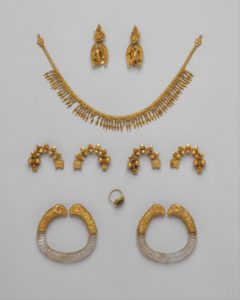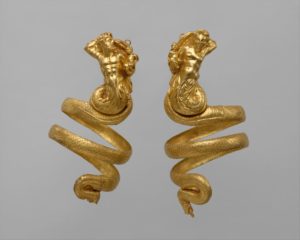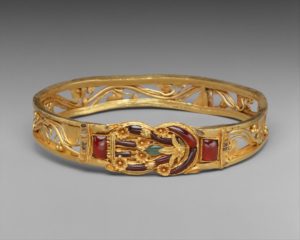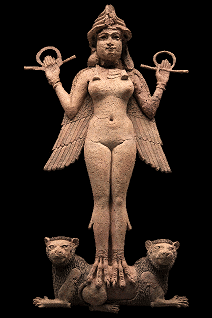
Hemingway, Colette, and Seán Hemingway. “Hellenistic Jewelry.” In Heilbrunn Timeline of Art History. New York: The Metropolitan Museum of Art, 2000–. http://www.metmuseum.org/toah/hd/hjew/hd_hjew.htm (April 2007)
This writing explains the background the jewelry in Hellenistic times and why it has the impact it does and the meaning behind it. Hemingway writes about how when Alexander the Great conquered the Persian empire in 331 B.C, his domain extended from Greece to Asia Minor, Egypt, the Near East, and India. This unprecedented contact with distant cultures not only spread Greek styles across the known world but also exposed Greek art and artists to new and exotic influences. Significant innovations in Greek jewelry can be traced even earlier to the time of Philip II of Macedon (r. 360/359–336 B.C.), father of Alexander the Great. An increasingly affluent society demanded luxurious objects, especially gold jewelry. After Alexander conquered the Persian empire and seized its fantastically rich treasures in Babylon, vast quantities of gold passed into circulation. The market for fashionable gold jewelry exploded. Even after the reign of Alexander, his successors for centuries supported flourishing industries of artists and craftsmen, the most important of whom were associated with the Hellenistic royal courts. This source is useful to my project because it helps me better understand the background of jewelry in ancient times and how it came to be.

LeGrand, Douglas S. “Early History of Jewelry: Ancient Times to the 17th Century.” International Gem Society, www.gemsociety.org/article/myth-magic-and-the-sorcerers-stone/.
This writing describes how jewelry was made and how it evolved from ancient times until now. Le Guin explains that the jewelry they wore in the old days was not made as we make it today. The Greeks were prolific writers and they often talked about jewelry and its impact on their day-to-day lives. As far back as 1200 BC, Greek jewelry was rich and varied and reflected the prosperity of the society. At first, the Greeks copied Eastern Motifs but then later developed their own style following their beliefs in the gods and symbols. Greek jewelry included crowns, earrings, bracelets, rings, hairpins, necklaces, and brooches. Greek women sometimes wore necklaces with 75 or more dangling miniature vases. Their jewelry combined the Eastern taste for gemstones and the Etruscan use of gold. The Etruscan perfected a method for making tiny gold beads called granulation. This work helped me better understand the materials and the making of ancient jewelry.

“Necklaces and Collars.” Pyramids of Ancient Egypt: Bent Pyramid of Sneferu, Dashur, www.ancientegyptonline.co.uk/jewellerycollar.html
This work described ancient jewelry and how the people of ancient Egypt used to wear their jewelry. The ancient Egyptians adored jewelry and loved to wear a variety of necklaces and collars made from a huge range of materials. Of course, only the wealthy could afford gold, silver or precious stones, but shells, wood, and bone were more readily available to those on a more restricted budget. Wealthy Egyptians could afford to buy beautifully crafted pieces of jewelry, but even those who could not afford the works of lesser craftsmen could employ their own ingenuity to make lovely pieces with which to adorn themselves. In art, the upper classes and the gods are almost always shown wearing a significant quantity of jewelry as a mark of their status. This particularly relates to collars and necklaces made from precious metals as these pieces of jewelry were often given as gifts by pharaoh to loyal supporters, making them a great source of personal pride. In biographies inscribed on the walls of their tombs, successful Egyptians are not slow to boast of every ocassion that their king rewarded their actions with a gift of a gold necklace!

O’Neil, Shannon Leigh. “Different Types of Ancient Egyptian Jewelry.” Synonym, 16 Mar. 2018, classroom.synonym.com/different-types-ancient-egyptian-jewelry-7270.html.
Ancient Egyptians believed strongly in the spiritual significance of jewelry. They wore it to protect their health, ward off evil spirits and bring good luck. Certain raw materials, designs and colors were associated with deities or symbolized supernatural powers. For example, carnelian, an orange-red stone, was a color suggestive of blood and therefore gave energy and potency to the ornament. Jewelers in ancient Egypt followed strict rules concerning the mystical aspects of their creations. They incorporated minerals into jewelry which conferred a symbolic meaning, such as amethyst, garnet, lapis lazuli, onyx and turquoise. They also used highly prized metals like gold, silver and copper.

Schorsch, Deborah. “Gold in Ancient Egypt.” In Heilbrunn Timeline of Art History. New York: The Metropolitan Museum of Art, 2000–. http://www.metmuseum.org/toah/hd/egold/hd_egold.htm (January 2017)
This writing explains the usage and importance of gold in Ancient Egypt. Egypt is a land rich in gold, and ancient miners employing traditional methods were thorough in their exploitation of economically feasible sources. In addition to the resources of the Eastern Desert, Egypt had access to the riches of Nubia, which is reflected in its ancient name, nbw (the Egyptian word for gold). The hieroglyph for gold—a broad collar—appears with the beginning of writing in Dynasty 1, but the earliest surviving gold artifacts date to the preliterate days of the fourth millennium B.C.; these are mostly beads and other modest items used for personal adornment. Gold jewelry intended for daily life or use in temple or funerary ritual continued to be produced throughout Egypt’s long history.









